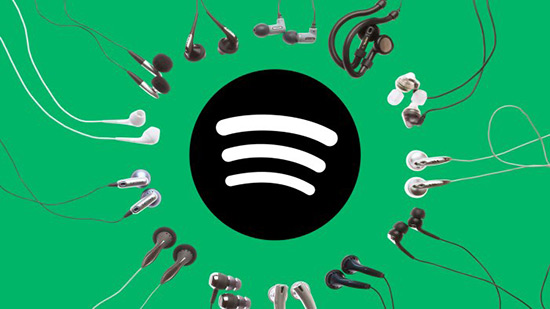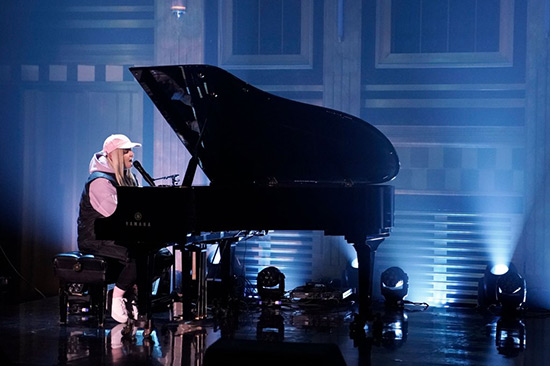无名艺人如何出人头地?Spotify歌单来帮忙

|
保罗·约翰逊低调地经营着一份名为Canyon City的音乐职业,同时还兼职零售、Uber司机,并为其他艺人灌制录音。随后,他的民谣流行歌曲《Firework》登上了2016年的Spotify歌单。如今,听众已经成为了Canyon City音乐的常客,而约翰逊也成为了一名职业音乐艺人,年收入约为20万美元。在他看来,其中的大部分都来自于点播版权费。 查特怒加市的这位歌手和吉他手称,这一变化主要源自于歌单曝光度。 30岁的约翰逊说,如果没有Spotify的话,“我可能就不会做音乐这一行了。”在首次登陆歌单之后,这位独立艺人的点播量迅速从每天数千次跃升至2万次,在接下来的第二年,其点播量在额外歌单的支持下增至约20万次。“我依然会制作音乐,但不会是现在这种全职的状态,而且我现在可以做很多事情,例如买房子,来一场远途旅行。” Spotify一直都是众多音乐人的批评对象,因为他们认为该平台支付的版权费较低,但一些小众艺人发现,如果自己的歌能够进入Spotify经营的3000个歌单中,那么就可以接触到听众,并以此来谋生。登陆歌单这种方式可以通过将其音乐推送给新听众,提升艺人的点播量,Spotify的一些歌单有着数千万的粉丝。 告示牌在去年11月的报道称,这些歌单曾经帮助洛杉矶歌手亚利桑那·泽瓦斯的点播量从每月50万次激增至每年约1080万次,而澳大利亚艺人托尼·沃森(又被称为Tones and I)在其歌曲《Dance Monkey》登陆多个国际歌单之后,于2019年斩获了6.1亿次的点播量。上述两位歌手均未对此置评。 |
Paul Johnson was scraping out a low-key music career under the name Canyon City while working part-time retail jobs, driving for Uber, and playing recording sessions for other artists. Then his folk-pop song “Firework” landed on a Spotify playlist in 2016. Now listeners stream Canyon City’s music often enough that Johnson is a full-time musician making around $200,000 a year, the “vast majority” of which he attributes to streaming royalties. It’s a change the Chattanooga singer and guitarist credits largely to playlist exposure. “I probably wouldn’t be doing this” without Spotify, says Johnson, 30, an independent artist who quickly jumped from a few thousand streams a day to 20,000 after the first playlist, and then grew to around 200,000 over the next year with additional playlist support. “I would still be making music, but not on the level where it’s a full-time career and I’m able to do things like buy a house and go on far-reaching tours.” Though Spotify has long been the scourge of musicians who think the platform doesn’t pay enough in royalties, some smaller artists are finding they can reach an audience, and make a living, if they can get their songs onto one of the 3,000 playlists that Spotify operates. Playlist placement can amplify the number of streams artists receive by putting their music in front of new listeners—some of Spotify’s playlists have tens of millions of followers. Playlists helped the Los Angeles singer Arizona Zervas jump from a half-million streams a month to 10.8 million in roughly a year, Billboard reported in last November, while Australian artist Toni Watson, known as Tones and I, has amassed more than 610 million streams in 2019 for her song “Dance Monkey” after it appeared on various international playlists. Neither singer was available for comment. |

|
马里兰州流行歌手萨拉·李(艺名REI AMI)到目前为止还未获得如此之大的成功,但其首支单曲《Snowcone》自去年9月登陆歌单之后已经获得了Spotify用户120万次的点播量。24岁的萨拉一开始对此并不抱太大的期望,然而在其歌曲出现在“反流行”歌单上之后,其点播量从每天1万次跃升至每天5万多次。她称其听众一直都说,他们通过Spotify才发现了萨拉。萨拉说:“我从未想过点播量会增加的如此之快。”对于音乐行业来说,她还是个新手,而且白天还有工作要做。“很明显,这个结果让我感到很高兴,但也令我感到措手不及,因为我从未想过,登陆歌单这样简单的事情能够开启我的音乐职业生涯。” 关键在于让自己的歌曲登陆歌单。Spotify艺人和厂牌营销团队负责人杰夫·斯特姆佩克表示,除了用户自己创建的歌单之外还有三种歌单。有的歌单是由算法创建的,旨在用歌曲数据匹配听众数据(例如“每日混合曲目”或“每周新歌”),有的歌单则是由Spotify100名左右的编辑精心打造,还有的歌单同时包含了算法和人工元素。斯特姆佩克说:“我们编辑策略的整体目标完全在于努力为用户提供适合他们的音乐。” 2018年7月的音频流服务在Spotify for Artists平台上引入了一个新的歌单提交工具,它实际上可以让音乐人通过一个在线表格,向歌单推荐音乐,这个表格涵盖的信息包括类别、场景、乐器和文化。Spotify编辑每周都会审核这些提交的内容,而且会根据数据以及个人直觉,将其中的一些歌曲导入歌单。 新的提交工具取代了此前毫无目标性的流程,也就是唱片公司和艺人可以通过任何方式联系,例如电子邮件、短信、Instagram的直接留言。斯特姆佩克说:“如今,整个流程变得无比清晰、透明和有序,编辑每周可以听到和编辑的音乐比以前要多得多。” 歌单不断增长的重要性在某种程度上重塑了艺人制作音乐的方式。当音乐人提交歌曲供歌单编辑审核时,歌曲曲调会自动出现在“周五新音乐”歌单中,该歌单由算法为其粉丝创建。Canyon City的保罗·约翰逊指出,与每年或每两年一次性发布一整张专辑的歌曲相比,一次放进一两首短时长歌曲更为合理,因为此举不仅更经济,而且也有助于与粉丝互动。约翰逊说:“它有助于让对话持续下去。”他还使用Spotify分析工具,按照其听众的所在地来预定巡演。 但也有艺人对此并不买账 Spotify没有明确透露自己每周会获得多少首提交的歌曲,也没有透露最终有多少歌曲进入了歌单,而那些希望这个流程更加透明的艺人对此颇有微词。南卡罗来州电子音乐艺人 Anjali of Diaspoura说:“除非有开源文件记录能够让所有作为工作者的艺人了解自己提交的歌曲如何进入其歌单,否则Spotify依然难以取得我的信任。”这位不到30岁的艺人于去年夏天在美国共同举行了五场艺人权利聚会,来讨论Spotify的薪酬政策。尽管Diaspoura的歌曲已经登陆Spotify,但这位艺人得以继续制作音乐的经费则来自于基于注册的众筹平台Patreon的收入。 Diaspoura并非是唯一不信任Spotify的艺人,艺人们对于平台的大多数疑虑都与薪酬政策有关。当Spotify于2006年问世时,由于对音乐人薪酬以及公司“免费”业务模式存在疑虑,不少艺人高调地收回了其音乐,包括披头士、齐柏林飞艇、平克·弗洛伊德和金属乐队。 另类摇滚乐队Letters to Cleo歌手、倡导团体“北美词曲作家”联合执行总监凯·汉莉指出,所有这些行动自此之后接踵而至,但这种做法如今没有任何优势可言。51岁的汉莉说:“这便是消费者选择倾听音乐的方式,而我觉得,制作音乐的所有目的便是为了让人们听音乐。因此,如果你切断了消费者几乎所有的入口通道,那还有什么意义呢?” 汉莉说她自己总的来说是流媒体音乐的粉丝,但她不会使用Spotify,因为该公司正在与其他机构一道起诉美国联邦版权委员会,因为后者最近做出决定,将订阅服务公司向词曲作家支付的薪酬提升44%。根据当前的规定,如果艺人自己演唱的歌曲(尤其这首歌由该艺人所写,而且是其母版录音的所有者)出现在Spotify的歌单上,那么艺人就可以获得薪酬。但陈旧的版权法规定,那些未演唱自己所写歌曲的词曲作家获得的收入要少得多,当前仅为总收入的10%,而演唱者能拿到60%,这意味着词曲作家基本与歌单的吸金效应无缘。 汉莉说:“如今,如果词曲作家既不是演唱者,也没有参与母版录制,那么他们完全依靠流媒体来谋生是不可能的。”版权费之争极其晦涩难懂,因为对于那些不受其影响的艺人来说,自己没有必要关注这件事情。作为母版录音的所有者,约翰逊依然对于自己基本上靠Spotify点播量来谋生的事实感到惊叹不已。他说:“我的巡演并不多,而且我是一名独立艺人。我当前并非只是勉强度日,而是处于蒸蒸日上的状态,这真是件疯狂的事情。”(财富中文网) 译者:冯丰 审校:夏林 |
Sarah Lee, a Maryland pop singer who performs as REI AMI, hasn’t reached those heights so far, but Spotify users have streamed her song “Snowcone”—Lee’s first-ever release—more than 1.2 million times since she put it out in last September. Lee, 24, had low expectations until the song showed up on the “Anti Pop” playlist and jumped from 10,000 streams a day to more than 50,000. She says her listeners tell her all the time that they discovered her through Spotify. “I never imagined things would pick up so rapidly,” says Lee, who is new enough to music that she still has a day job. “And it was obviously so great to see, but it was almost overwhelming because I just never thought that simply being playlisted would jump-start my career.” The trick is getting your song on a playlist. Apart from user-created playlists, there are three kinds, says Jeff Stempeck, a team lead on artist and label marketing at Spotify. There are playlists populated by an algorithm that seeks to match song data with listener data (“Your Daily Mix,” for example, or “Discover Weekly”), human-curated playlists tended by 100 or so editors at Spotify, and playlists that combine algorithmic and human elements. “The overall goal with our editorial strategy, it’s really all about trying to serve the right music to the right users,” Stempeck says. The streaming service in July 2018 introduced a new playlist submission tool on its Spotify for Artists platform, which allows musicians to essentially pitch songs for playlist consideration through an online form that includes information like genre, mood, instrumentation, and culture. Spotify editors review the submissions weekly and, through a combination of data and gut feeling, steer some of them into playlists. The new submission tool replaced a more scattershot process in which record labels and artists would get in touch however they could: email, text messages, direct messages on Instagram. “Now it’s an incredibly clear, transparent, organized process where editors can listen to way more music and program a lot more songs each week,” Stempeck says. The growing importance of playlists is, in some ways, shaping how artists make music. When musicians submit a song for editorial playlist consideration, the tune will automatically appear in the “New Music Friday” playlists that are algorithmically created for their followers. Rather than releasing a full album’s worth of tunes every year or two and submitting one tune for playlist consideration, Canyon City’s Paul Johnson says putting out one or two songs at a time at shorter intervals makes more sense, economically and in terms of fan engagement. “It helps keep a conversation going,” says Johnson, who also uses Spotify analytics to book tours based on places where users are listening to his music. But artists aren’t fully sold Spotify won’t specify how many submissions it gets per week, or how many of them end up on playlists, which irks musicians who want to see a more transparent process. “Until there is some sort of open source documentation for all artists as workers to see exactly how our submissions are funneling into their playlists, Spotify will remain untrustworthy to me,” says Anjali of Diaspoura, a South Carolina electronic artist under 30 who co-organized five artists’ rights rallies around the country last summer to discuss Spotify’s compensation practices. Though Diaspoura’s songs are on Spotify, the artist relies on income from the subscription-based crowdfunding platform Patreon to continue making music. Diaspoura isn’t the only Spotify skeptic, and most of the misgivings musicians have about the platform revolve around the issue of compensation. When Spotify launched in 2006, concerns about musicians’ pay and the company’s “freemium” business model prompted more than a few high-profile acts to withhold their music, including the Beatles, Led Zeppelin, Pink Floyd, and Metallica. All those acts have since come around, and these days there’s no advantage to that approach, says Kay Hanley, singer for the alt-rock band Letters to Cleo and co-executive director of the advocacy group Songwriters of North America. “This is how consumers have chosen to listen to music,” says Hanley, 51. “And the whole point of making music, I think, is for people to hear it. So if you're cutting off pretty much every entryway to the consumer, what is the point?” Hanley says she’s a fan of streaming music services in general, but she won’t use Spotify because the company is among those appealing a recent decision by the federal Copyright Royalty Board to increase by 44% the compensation that subscription services pay to songwriters. Under current rules, artists on Spotify can make money if a song they perform ends up on a playlist, especially if they wrote the song and own the master recording. Because of archaic copyright laws, songwriters who do not perform the songs they write are paid much less—currently just 10% of the overall revenue, compared to 60% for performers—meaning the playlist bonanza effectively leaves out songwriters. “There is no world where a songwriter can make a living with streaming as your only source of revenue if you’re not the artist, and you have no participation in the master,” Hanley says. The royalty dispute is arcane enough that it doesn’t always resonate with artists who aren’t affected by it. Johnson, who owns his master recordings, still marvels over the fact that he is making a living largely through Spotify streams. “I don’t tour too much, and I’m an independent artist,” he says. “So it’s really kind of wild to me that I’m not just getting by, but really kind of thriving.” |













